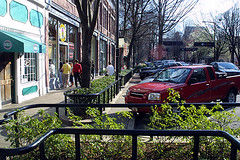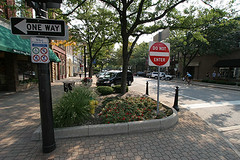Industry study: Americans want smart growth

Posted April 7, 2011 at 1:26PM
Americans decidedly favor walkable, mixed-use neighborhoods, says a new industry study. In fact, 56 percent of us prefer smart growth neighborhoods over those that require more driving between home, work and recreation. These findings are from the just-released Community Preference Survey sponsored by the National Association of Realtors®.
“Realtors® care about improving communities through smart growth initiatives,” said NAR President Ron Phipps, in a press release posted Monday on the Association’s web site. Phipps is broker-president of Phipps Realty in Warwick, R.I. “Our members don’t just sell homes, they sell neighborhoods. Realtors® understand that different home buyers are looking for all kinds of neighborhood settings and that many home buyers want walkable, transit-accessible communities.”
Walkable communities were defined in the survey as those where shops, restaurants, and local businesses are within walking distance from homes. According to the survey, when considering a home purchase,  77 percent of respondents said they would look for neighborhoods with abundant sidewalks and other pedestrian-friendly features, and 50 percent would like to see improvements to existing public transportation rather than initiatives to build new roads and developments.
77 percent of respondents said they would look for neighborhoods with abundant sidewalks and other pedestrian-friendly features, and 50 percent would like to see improvements to existing public transportation rather than initiatives to build new roads and developments.
The survey also revealed that, while space is important to home buyers, many are willing to sacrifice square footage for less driving. Although eighty percent of those surveyed would prefer to live in a single-family, detached home as long as it didn’t require a longer commute, nearly three out of five of those surveyed – 59 percent – would choose a smaller home if it meant a commute time of 20 minutes or less.
The survey also found that community characteristics are very important to most people. When considering a home purchase, 88 percent of respondents placed more value on the quality of the neighborhood than the size of the home, and 77 percent of those surveyed want communities with high-quality schools.
These findings are welcome and mostly consistent with others, but the extent of the preferences for single-family homes and good school districts is somewhat inconsistent with other research and perhaps particularly reflective of what one would expect from certain demographic groups such as families with children. A much higher portion of single adults and empty-nesters would be expected to seek multifamily living or townhomes,  and I would also expect fewer of those categories to have strong preferences for places with good schools. It is not clear from the study how respondents were contacted and recruited (“Panel members are randomly recruited through probability-based sampling” . . . “Knowledge Networks selects households by using address-based sampling methods.”)
and I would also expect fewer of those categories to have strong preferences for places with good schools. It is not clear from the study how respondents were contacted and recruited (“Panel members are randomly recruited through probability-based sampling” . . . “Knowledge Networks selects households by using address-based sampling methods.”)
Perhaps it's the qualification "as long as it didn't require a longer commute" that raised the portion of respondents favoring single-family homes. Analysts Zimmerman Volk Associates have reported that as much as 38 percent of the market prefers attached or multifamily homes and that, of the 62 percent preferring single-family, most prefer homes with small (7,000 square feet or smaller) lots. 85 percent of the projected growth in demand for housing will come from households without children, according to research by Robert Charles Lesser & Co. in general, demographic trends show households with children remaining an important but diminishing portion of the overall US housing market.
In the new Realtors survey, single adults age 35 or younger were found to have a very strong preference for a neighborhood with a mix of houses and businesses (73%) over an area with housing only (25%). This category also indicated a marked preference for an apartment or townhouse within an easy walk of places (56%) over a single-family home that requires more driving (39%). Nearly seven in ten (68%) chose a smart growth community over a sprawl community (31%).
NAR indicates that the survey of 2,071 adult Americans was conducted by Belden, Russonello and Stewart from February 15-24, 2011.
Move your cursor over the images for credit information.
